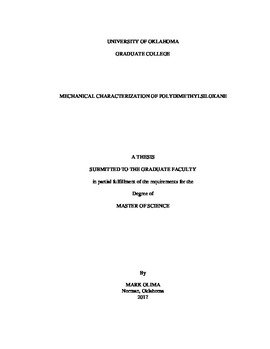| dc.description.abstract | Strain and displacement are critical parameters for mechanical characterization of materials. Measuring these parameters accurately can be challenging for hyper-elastic materials such as polydimethylsiloxane (PDMS) due to their non-linear deformation at strains above 30%. This restriction has led researchers to stick to application based modelling when it comes to using hyper-elastic materials in developing strain based sensors. This means that linear stress-strain relationship from 0-30% provides a predictable frame to design sensors using this material.
This thesis explores three different methods that can be used in measuring the strain of PDMS. The use of crosshead displacement, video extensometer and Digital Image Correlation (DIC) for strain measurement were compared. These three methods vary in complexity and cost to run. The most common method is the use of crosshead displacement since it is incorporated in the machine and hence does not require any additional devices to run an experiment. The next method is DIC which requires a digital single-lens reflex camera to take the images of the sample as it undergoes either a tension or compression test. It also requires the most amount of computation since the images taken have to be correlated using another software and the resulting strain matched to their corresponding stress from the raw data stored in the test machine. Lastly, it’s by use of a video extensimeter. These methods are commonly used by researchers in the characterization of mechanical properties of hyper-elastic materials and therefore it would be prudent to compare their utility.
The focus will be mainly on DIC because more information about the material can be extracted from the data obtained from using this method. DIC analysis was done using both an open source Matlab code and commercial DIC software called LabJoyTM.
Tension and compression PDMS samples were tested and their strain measurements analyzed to fully understand the material characteristics.
The PDMS used in this study was sourced from two different manufacturers. Sylgard 184 was purchased through a third party from Dow Corning. Tension and compression Sylgard samples were characterized as a function of five different temperatures, 25°C, 80°C, 100°C,120°C and 150°C. The other manufacturer is Gelest Inc. They provided PDMS in five different components thereby giving us the flexibility to vary the actual PDMS contents. Silica was varied to give tension and compression samples containing 9%, 18%, 22% and 30% silica by weight.
In this research it was discovered that the gage section in tension samples experienced 20% more strain than what the crosshead records, the Poisson ratio was 0.46 and 0.61 for the tension and compression sample respectively. There was a 25% increase in the Young’s modulus of the Sylgard when the cure temperature was changed from 25°C to 150°C tension sample and a 32% increase in the modulus of the Gelest compression sample when the silica was changed from 9% to 30%. The modulus of the compression sample increased by 61% with a 21% increase in silica, which indicated a 3:1 ratio.
In addition to mechanical characterization, thermal stability and viscoelastic material properties of PDMS were tested. Tan delta plots from dynamic mechanical analysis showed that the glass transition temperature of all the Sylgard samples cured at different temperatures were around -125°C. Thermogravimetric test showed that Sylgard undergoes one stage decomposition while Gelest undergoes a two stage decomposition.
The first stage is between 400°C and 600°C in both Sylgard and Gelest while the second stage in Gelest is between 550°C and 750°C. | en_US |
